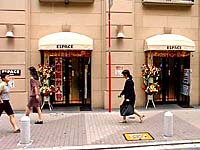It is said that Pachinko was invented in Nagoya after WWII. Pachinko developed the idea of Pinball and changed the playing area into vertical position. However, this minor change gave the game a speedy movement and an evil fascination.
Pachinko parlors at the beginning offered 20 balls in return for each tiny stainless ball going into a safe slot. This high-rate return gave Pachinko an instant success. In the early 1950s there were over 30 thousand Pachinko parlors in Japan.

an early digital Pachinko |  |

a current model |
Pachinko is a gamble.:
The reason for the popularity of Pachinko is simple. It is an easy gamble.
Players can change the collected balls with prizes at counters of Pachinko parlors, as you might easily imagine. But, this is not the end of the game. You should name specific prizes - in most parlors they are such ordinary things as soap and razor and they are determined by the parlors. If you take them to a certain small shop .. or a small window ... near the parlor, you can change them with cash.
This "prize buy-back system" determines the character of Pachinko and ensures its popularity among Japanese. Pachinko is in reality not a simple game but a sort of gamble. Though private gambles are totally forbidden in Japan, police controlled Pachinko only when it arouses too much passion for gambling.
Pachinko and technology:
20 balls bonus was soon forbidden by the police, because it excessively fascinated ordinary people.
Then Pachinko makers invented so called "
tulip" slits in 1960. When a ball runs into one of the specially made holes, tulip petal like parts which till then rather strictly covered the entrance of the hole suddenly open and allow another balls to jump into the hole more easily. Players can therefore get bonus after bonus.
Tulip is just an example. New and advanced technology continuously brought innovation to Pachinko machines. So, launching of balls soon came to be controlled mechanically, namely only by turning a control knob. Also, already in the 1970s, the flow of millions of steel balls of a Pachinko parlor came to be controlled by computer.
At the end of 1970's Pachinko experienced very severe time, because the first generation of computer games - "
invader game" - overwhelmed Japan. However, Pachinko business introduced so called
"fever" machine, which combined slot machine and Pachinko using digital technology and promised much bigger returns. Pachinko successfully recovered its patrons.
Pachinko is tolerated.:
Though Pachinko parlors were infamous as evading tax and the buy-back of prizes were important financial resources for Mafia, Pachinko was generally accepted by everyone as common entertainment around the corner by the end of the 1980s.
Pachinko money:
Then Pachinko parlors introduced
prepaid cards at the beginning of the 1990s, even very conservative and established large-scale enterprises tried to have a share in the otherwise very neglected and disdained business, as prepaid card system promised a juicy profit.
However, high-tech cards were faked in hundreds and thousands. In many cases, Chinese, Iranian or other foreigners were involved in this crime. As a result, the companies involved in the prepaid card business suffered an enormous loss.
Pachinko and the police:
Around that time, the prize buy-back system came to be operated more and more openly. This gave the police to intervene more deeply into the Pachinko business. Pachinko business is now more or less controlled by the police. This means that the collaboration between Pachinko business and the police became very intensive and we often see ex-police officers working in Pachinko related companies.

a shabby Pachinko parlor
in a local town

the most trendy parlor in Akasaka |
:
The expenditure at tens of thousands of Pachinko parlors well exceeds the Japanese defense budget. In local towns the most gorgeous looking buildings are always Pachinko parlors. It is said that
the lion's share of the donation to the North Korea by resident Koreans in Japan (*) is from Pachinko parlor owners (**). If this proves to be true .. and I presume that it is very probable ... it means that the Japanese Pachinko players are, either consciously or unconsciously, contributing to the preservation of the North Korean regime and their Tepodong development
:-p.
- (*)
- According to an American source it was US 500 - 600 million $ at the beginning of 1990s.
- (**)
- A large part of Pachinko parlor owners are Koreans.
class=rPachinko and moms:
Pachinko is a very addictive entertainment. When I was a student, I went to Pachinko parlors nearly every day. At the time the system was still manual and we could enjoy Pachinko for 30 minutes or so by US 30 cents :-) even though we didn't have luck. Nowadays, machines are fully automatic and you can easily lose US 100 $ within 10 minutes. Nevertheless, many people become addictive. I often hear about mothers who become crazy about Pachinko and leave their babies in their cars on open-air car park. While they indulge in playing,
babies die by heat stroke or suffocation :-(
So, it is obvious that Pachinko is a very big evil. However, like cigarette, it is very difficult to stop, once you become addictive. I can also say that Pachinko is one of the representative Japanese inventions for entertainment in addition to Karaoke, Tamagocchi, Anime and Nintendo.
Sometime ago, I asked an older female colleague what her hobby was. Her answer was
"
Horse race and Pachinko".
Very brave woman ;-)



